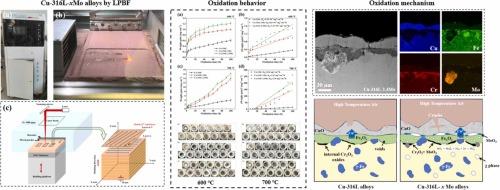激光粉末床熔合制备Cu-316L-xMo非混相合金的氧化机理
IF 6.3
2区 材料科学
Q2 CHEMISTRY, PHYSICAL
引用次数: 0
摘要
采用激光粉末床熔合法制备了Cu-316L-xMo非混相合金。研究了3种Cu-316L-xMo合金在600 °C和700 °C时的氧化行为,揭示了Mo对氧化动力学、氧化垢形成和完整性的影响。结果表明:氧化后表面形成了由CuO和Fe2O3组成的非均相氧化层,且由于ε-Cu和γ-Fe相的不混溶,形成了局部变化的氧化层厚度;Mo离子的加入加速了Cu-316L-xMo合金的氧化速率。MoO3的高挥发性损害了氧化层的完整性,特别是在高温下。此外,在热循环过程中氧化皮内部产生的生长和热应力导致氧化皮严重开裂和剥落。本文章由计算机程序翻译,如有差异,请以英文原文为准。

The oxidation mechanism of heterogeneous structured Cu-316L-xMo immiscible alloys by laser powder bed fusion
Cu-316L-xMo immiscible alloys were manufactured by laser powder bed fusion (LPBF) in this work. The oxidation behavior of three types Cu-316L-xMo alloys at 600 °C and 700 °C were studied to reveal the influence of Mo on the oxidation kinetics, oxide scale formation and integrity. The results showed that a heterogeneous oxide layer composed of CuO and Fe2O3 was formed on the surface after oxidation, and locally varying oxide-thicknesses is observed due to the immiscibility of ε-Cu and γ-Fe phases. The incorporation of Mo ions into the oxide scale accelerates the oxidation rate of Cu–316L–xMo alloys. The high volatility of MoO3 compromises the integrity of the oxide scale, especially at higher temperature. Moreover, the growth and thermal stresses developed within the oxide scale during thermal cycling leads to severe cracking and spallation of the oxide scale.
求助全文
通过发布文献求助,成功后即可免费获取论文全文。
去求助
来源期刊

Journal of Alloys and Compounds
工程技术-材料科学:综合
CiteScore
11.10
自引率
14.50%
发文量
5146
审稿时长
67 days
期刊介绍:
The Journal of Alloys and Compounds is intended to serve as an international medium for the publication of work on solid materials comprising compounds as well as alloys. Its great strength lies in the diversity of discipline which it encompasses, drawing together results from materials science, solid-state chemistry and physics.
 求助内容:
求助内容: 应助结果提醒方式:
应助结果提醒方式:


